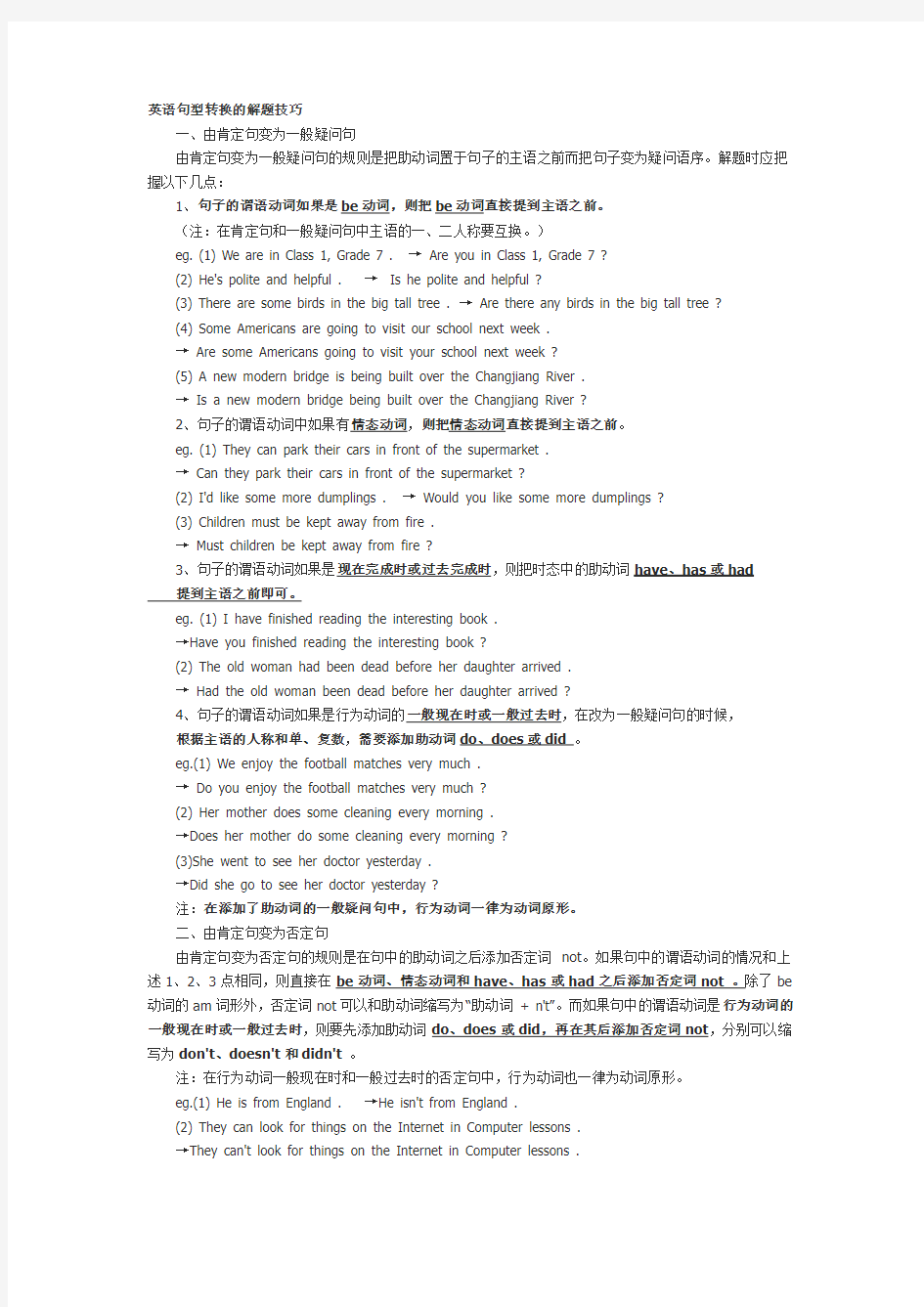句型转换解题技巧

- 1、下载文档前请自行甄别文档内容的完整性,平台不提供额外的编辑、内容补充、找答案等附加服务。
- 2、"仅部分预览"的文档,不可在线预览部分如存在完整性等问题,可反馈申请退款(可完整预览的文档不适用该条件!)。
- 3、如文档侵犯您的权益,请联系客服反馈,我们会尽快为您处理(人工客服工作时间:9:00-18:30)。
英语句型转换的解题技巧
一、由肯定句变为一般疑问句
由肯定句变为一般疑问句的规则是把助动词置于句子的主语之前而把句子变为疑问语序。解题时应把握以下几点:
1、句子的谓语动词如果是be动词,则把be动词直接提到主语之前。
(注:在肯定句和一般疑问句中主语的一、二人称要互换。)
eg. (1) We are in Class 1, Grade 7 . →Are you in Class 1, Grade 7 ?
(2) He's polite and helpful . →Is he polite and helpful ?
(3) There are some birds in the big tall tree . →Are there any birds in the big tall tree ?
(4) Some Americans are going to visit our school next week .
→Are some Americans going to visit your school next week ?
(5) A new modern bridge is being built over the Changjiang River .
→Is a new modern bridge being built over the Changjiang River ?
2、句子的谓语动词中如果有情态动词,则把情态动词直接提到主语之前。
eg. (1) They can park their cars in front of the supermarket .
→Can they park their cars in front of the supermarket ?
(2) I'd like some more dumplings . →Would you like some more dumplings ?
(3) Children must be kept away from fire .
→Must children be kept away from fire ?
3、句子的谓语动词如果是现在完成时或过去完成时,则把时态中的助动词have、has或had
提到主语之前即可。
eg. (1) I have finished reading the interesting book .
→Have you finished reading the interesting book ?
(2) The old woman had been dead before her daughter arrived .
→Had the old woman been dead before her daughter arrived ?
4、句子的谓语动词如果是行为动词的一般现在时或一般过去时,在改为一般疑问句的时候,
根据主语的人称和单、复数,需要添加助动词do、does或did 。
eg.(1) We enjoy the football matches very much .
→Do you enjoy the football matches very much ?
(2) Her mother does some cleaning every morning .
→Does her mother do some cleaning every morning ?
(3)She went to see her doctor yesterday .
→Did she go to see her doctor yesterday ?
注:在添加了助动词的一般疑问句中,行为动词一律为动词原形。
二、由肯定句变为否定句
由肯定句变为否定句的规则是在句中的助动词之后添加否定词not。如果句中的谓语动词的情况和上述1、2、3点相同,则直接在be动词、情态动词和have、has或had之后添加否定词not 。除了be 动词的am词形外,否定词not可以和助动词缩写为“助动词+ n't”。而如果句中的谓语动词是行为动词的一般现在时或一般过去时,则要先添加助动词do、does或did,再在其后添加否定词not,分别可以缩写为don't、doesn't和didn't 。
注:在行为动词一般现在时和一般过去时的否定句中,行为动词也一律为动词原形。
eg.(1) He is from England . →He isn't from England .
(2) They can look for things on the Internet in Computer lessons .
→They can't look for things on the Internet in Computer lessons .
(3) I have seen the interesting film already . →I haven't seen the interesting film yet .
(4) His brother often plays football after school .→His brother doesn't often play football after school .
(5) My grandma came for dinner yesterday evening .
→My grandma didn't come for dinner yesterday evening .
下面几种句型在变为否定句时情况特殊一些,做题时须引起注意:
(1) I think + 宾语从句。
该句型在变为否定句时,否定词not应放在主句上,即为:I don't think + 宾语从句。
eg. I think it will rain tomorrow .
→I don't think it will rain tomorrow .
(2) 祈使句
祈使句的特征是没有主语,以动词原形开头。在变为否定句时,应在动词原形之前添加助动词don't .
eg. (1) Water the flowers .
→Don't water the flowers .
(2) Please clean the blackboard .
→Please don't clean the blackboard .
三、句子的单复数互换
句子的单复数转换的规则是:对应句中的名词、代词、动词等,能变则变,不能变的,要么保留,要么去掉。要做到熟练掌握并运用这一规则,必须掌握名词的单复数的变化规则,代词对应的人称和单复数,动词的第三人称单数的变化规则等。在解题过程中,还必须具体情况具体对待。
eg. (1) The girl is from England .
→The girls are from England .
(2) He is a polite and helpful boy .
→They are polite and helpful boys .
上述例句中,划线的为能变的,没划线的为该保留的,加号的a(an)为该去掉的。反之,在由复数变为单数时,则要根据句意在名词之前补上一个a (an)。
eg. They are English girls .
→She is an English .
但是对于"There be"句型,单复数转换时句中的a / an不能去掉,而要根据句式将其与some或any 互换。
eg. (1) There is a boat on the lake .
→There are some boats on the lake .
(2) There isn't a tree behind the house .
→There aren't any trees behind the house .
(3) Is there a pet dog in your home ?
→Are there any pet dogs in your home ?
(4) There aren't any pictures on the wall of our classroom .
→There isn't a picture on the wall of our classroom .
四、同义句转换
同义句转换就是将所给的句子换个说法。这一题型包含的内容多,形式杂。有词汇的同义转换,句型的同义转换,等。掌握该题型的解题技巧,可以很好地帮助学生理解、掌握所学的词汇和句型的含义,并在此基础上加以活用,对学生形成语言综合运用能力有极大的帮助。要掌握该题型的正确的解题方法,需要在日常的英语学习中不断练习、归纳、积累。一般说来,同义句转换主要有以下几种形式:
